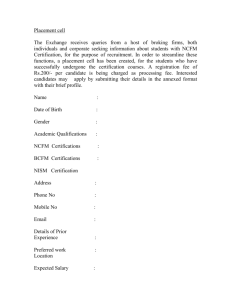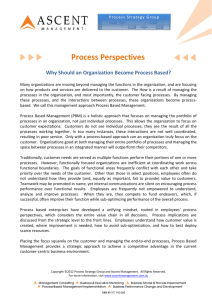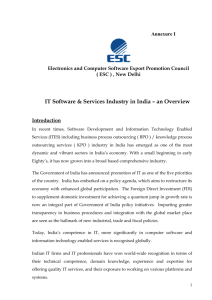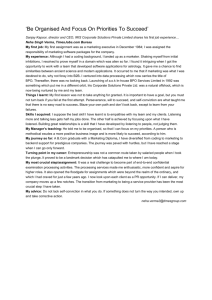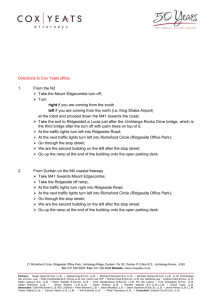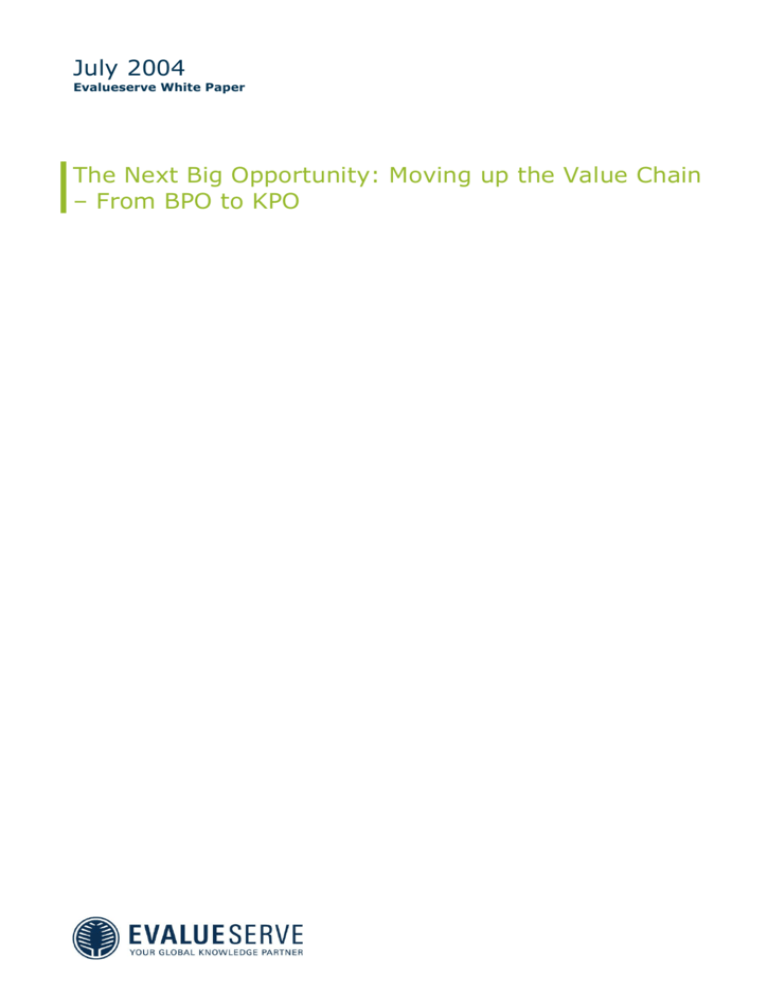
July 2004
Evalueserve White Paper
The Next Big Opportunity: Moving up the Value Chain
– From BPO to KPO
2
The Next Big Opportunity: Moving up the Value Chain – From BPO to KPO
Table of Contents
Introduction ........................................................................................................................... 3
What is KPO? .......................................................................................................................... 4
KPO – The Opportunity and Associated Challenges ....................................................................... 5
BPO and KPO – Estimated Size of Opportunity ......................................................................... 5
High-end KPO Opportunities – Some Examples ........................................................................ 6
Challenges in KPO ............................................................................................................... 7
Drivers Behind the BPO to KPO Shift .......................................................................................... 9
Factors Fuelling the BPO to KPO Movement ............................................................................. 9
Increasing Number of Professionals in the Offshoring Industry ..................................................10
The Big Irony – Protectionist Lobby is in Reality Boosting the
Offshoring Trend ................................................................................................................10
Key Low-wage Offshore Locations: A Comparative Study .............................................................12
Future Outlook...................................................................................................................13
Appendix ..............................................................................................................................15
Emerging KPO Sourcing Models – InnoCentive: A Case Study on
Research and Development .................................................................................................15
Evalueserve Contact ...............................................................................................................17
About Evalueserve ..................................................................................................................17
Evalueserve Disclaimer ...........................................................................................................17
www.evalueserve.com | © 2014 Evalueserve. All Rights Reserved
3
The Next Big Opportunity: Moving up the Value Chain – From BPO to KPO
Introduction
The success in offshoring Business Process operations with respect to reducing costs and often
improving quality has encouraged many firms to start offshoring their high-end knowledge work as
well. Their underlying expectation is that offshoring high-end processes will result in additional cost
savings and operational efficiencies, coupled with access to very good talent in the low-wage offshore
countries. In this paper, we will refer to this offshoring of higher-end services as Knowledge Process
Offshoring (KPO).
This paper analyzes the evolving KPO market, the opportunities it offers, the associated challenges, and
the key drivers associated with the move from BPO to KPO.
According to our estimate, the KPO market is expected to grow from USD 1.2 billion in FY1 2003 to USD
16 billion in FY 2010. The sectors that are expected to ‘shine’ within the KPO industry include data
search, integration and management services, financial and insurance research, biotech and
pharmaceutical research and computer-aided simulation and engineering design.
In terms of challenges, this paper analyzes the impact of key parameters such as quality, precision,
confidentiality and project management expertise in the KPO industry. This paper also forecasts the
number of professionals that are likely to be employed by this industry and we also present some
important drivers behind the movement from BPO to KPO.
Finally, this paper attempts to compare countries (such as China, India, the Philippines, Ireland, Israel
and Russia) that can provide KPO services with respect to labor costs, geographic location,
demographic factors and other miscellaneous factors. The paper also discusses the future outlook of
the global offshoring industry.
1
FY stands for Financial Year, which starts from April 1 st of one year and goes to March 31st of the next. E.g. FY 2003 refers to the period
between April 1, 2003 and March 31, 2004
www.evalueserve.com | © 2014 Evalueserve. All Rights Reserved
4
The Next Big Opportunity: Moving up the Value Chain – From BPO to KPO
What is KPO?
The maturity and evolution of outsourcing strategies is leading businesses to shift towards the
offshoring of high-end processes to low-wage destinations, a trend referred to as KPO. This involves
offshoring of knowledge-intensive business processes that require significant domain expertise.
In comparison to BPO, KPO delivers higher value to organizations that offshore their domain-based
processes, thereby enhancing BPO’s traditional cost-quality paradigm. The central theme of KPO is to
create value for the client2 by providing business expertise rather than process expertise. Hence, KPO
entails the shifting from simple execution of ‘standardized processes’ to carrying out processes that
demand advanced analytical and technical skills as well as decisive judgment. Figure 1 provides two
examples – one relating to IT services and the other relating to insurance services.
Figure 1: Examples of two industries – Gradual Migration from Low-end (BPO) to High-end
(KPO) Offshoring
IT Industry
Programming
and
Maintenance
Services
Project
Implementation
PackageImplem
entation
System
Integrations
Insurance
Industry
Contact Centers
& Customer
Support
Claims
Processing &
Policy Servicing
Underwriting &
Asset
Management
Knowledge Process
Operations: Domain
Expertise required
100% off-shoring
possible
IT-ledBusiness
Strategy
80:20 or (100-x) : x
delivery model
Source: Evalueserve Analysis
With global businesses becoming more competitive, the cycle time for introducing products and
services has become smaller, and customers are more demanding with respect to the quality of
services provided. This has forced enterprises to adopt systems and business models that will not only
provide operational efficiency, but also add strategic value to their products and services.
KPO services can enable enterprises to reduce design-to-market lead times; manage critical hardware
efficiently; provide research on markets, competition, products and services; enhance organizational
effectiveness in business administration; and help in dealing with rapidly evolving business scenarios.
Finally, the outsourcing solutions for high-end processes, unlike traditional BPO solutions that are
commoditized fixed-price solutions, are usually customized and value based. It is often this
customization that enhances the value proposition of KPO.
2
Client refers to the organization that outsources its processes
www.evalueserve.com | © 2014 Evalueserve. All Rights Reserved
5
The Next Big Opportunity: Moving up the Value Chain – From BPO to KPO
KPO – The Opportunity and Associated Challenges
This section analyzes the opportunities presented by the KPO industry and also identifies some of the
challenges that this emerging industry might face in the near future.
BPO and KPO – Estimated Size of Opportunity
Evalueserve predicts that low-end outsourcing services will grow globally from USD 7.7 billion in FY 3
2003 to USD 39.8 billion in FY 2010, which implies a Cumulative Annual Growth Rate (CAGR) of 26
percent.
In contrast, the revenue from the global KPO market was USD 1.2 billion in FY 2003 and this is
expected to grow to USD 17 billion by FY 2010, which implies a CAGR of 46 percent (according to
Evalueserve).
Figure 2 demonstrates the expected growth in the BPO and KPO markets over the next seven years.
Figure 2: Expected Growth in Global BPO and KPO Markets (2003-2010)
Size (US $ billion)
60
50
40
30
CAGR (KPO) = 45 %
20
CAGR (BPO) = 26 %
10
0
FY 2003
BPO
FY 2010
KPO
Source: Evalueserve Analysis
The following is a list of potential high-end services for the KPO sector.
1. Intellectual Property (IP) research
2. Equity, financial, and insurance research
3. Data search, integration, and management
4. Analytics (data analytics/risk analytics) and data mining services
5. Research and information services in human resources (HR)
6. Business and market research (including competitive intelligence)
7. Engineering and design services
3
FY stands for Financial Year, which starts from April 1 st of one year and goes to March 31st of the next. E.g. FY 2003 refers to the period
between April 1, 2003 and March 31, 2004
www.evalueserve.com | © 2014 Evalueserve. All Rights Reserved
6
The Next Big Opportunity: Moving up the Value Chain – From BPO to KPO
8. Design, animation, and simulation services
9. Paralegal content and services
10. Medical content and services
11. Remote education and publishing
12. Pharmaceuticals and biotechnology
13. Research and Development (IT and non-IT areas)
14. Network management
15. Decision Support Systems (DSS)
Table 1 provides the Evalueserve estimate on the market size of some of the above-mentioned highend processes over the next seven years.
Table 1: Comparative Opportunities in the KPO Market (2003-2010)
KPO Sectors
Equity, Financial, Insurance Research
FY 2003
FY 2010
CAGR
0
0.4
N/A
0.3
5.0
50%
0
0.2
-
0.01
0.4
70%
Engineering and Design
0.4
2.0
29%
Animation and Simulation Services
0.1
1.4
46%
Paralegal Content and Services
0
0.3
N/A
Medical Content and Services
0
0.3
N/A
Remote Education and Publishing
0
2.0
N/A
0.28
3.0
40%
0.2
2.0
39%
1.29
17.0
46%
Data Search, Integration and Management
Research and Information Services in HR
Market Research and Competitive Intelligence
Biotech and Pharmaceuticals (CRO, lead optimization, and
manufacturing processes)
Research and Development
Total (USD Billion)
High-end KPO Opportunities – Some Examples
The following are some examples of high-end KPO:
Intellectual Property Research (IPR)
•
Drafting and filing of patent applications with the United States Patent and Trademark Office
(USPTO) is expensive; and a typical patent application may cost between USD 10,000 and USD
15,000.
www.evalueserve.com | © 2014 Evalueserve. All Rights Reserved
7
The Next Big Opportunity: Moving up the Value Chain – From BPO to KPO
•
An Intellectual Property (IP) specialist in an offshore location can produce a preliminary draft of a
patent application, which is then reviewed and modified by a registered US patent attorney, before
it is filed with the USPTO.
•
Offshoring even a small portion of the patent-drafting process can save up to 50 percent of the
total cost (for the end client).
•
IP asset management, IP landscaping of technology domains, IP licensing, IP docketing, and IP
commercialization services are some other services that can be offshored in a similar manner.
These services can be provided not only for patents but also for trademarks, copyrights, and other
Intellectual Property.
•
Some law firms in the US have already set up their back-end centers in India, and others are
joining hands with Indian companies for this purpose.
Offshoring R&D in Pharmaceuticals and Biotechnology
•
Contract research organizations are being widely used by pharmaceutical companies. Other
emerging areas within this sector include lead optimization and improvement of manufacturing
processes.
•
The global contract research market is estimated to grow to USD 20 billion by 2004.
•
Destinations such as India offer significant cost advantages – often as much as 40-60 percent – in
the areas of contract research and clinical trials.
•
Recently, companies such as AstraZeneca and Glaxo-Smith-Kline have set up drug discovery
centers at low-cost destinations thereby offshoring their R&D.
Analytics and Data Mining Services
•
Companies can save significantly – as much as 60-70 percent – by offshoring data mining,
analytics, and inventory management work to low-wage countries.
•
Demand and channel planning, manufacturing scheduling, and transport planning are examples of
some supply-chain management solutions that require the use of mathematical programming,
statistical analysis, and computer-aided simulations.
•
Destinations such as Russia and India are ideal for these services because they provide a large pool
of engineers and even PhDs at substantially low costs. The cost differential between a PhD in the
Sciences and Engineering in the US and in India (or between the US and Russia) can range between
USD 60,000 and USD 80,000, respectively.
Challenges in KPO
KPO presents substantial opportunities for players in the outsourcing business. However, there are
some formidable challenges in the path of their development, which include the following:
•
Processes executed within the KPO domain require higher quality standards because the stakes for
the clients are high. Furthermore, the clients are likely to be apprehensive about the quality of
services delivered (especially in view of the fact that these services are being provided by low-cost
destinations) and these may be difficult to alleviate.
www.evalueserve.com | © 2014 Evalueserve. All Rights Reserved
8
The Next Big Opportunity: Moving up the Value Chain – From BPO to KPO
•
In some cases, investment in KPO infrastructure is expected to be higher than that in traditional
BPO. For example, a company involved in Simulation and Finite Element Analysis will require highend workstations, whereas one involved in simple data collection, sorting, and analysis may require
moderate capital. Similarly, contract research organizations are likely to require higher amounts of
capital.
•
The lack of a good talent pool for the execution of projects may often prove to be a hindrance in
many countries.
•
KPO projects require a higher level of control, confidentiality and enhanced risk management.
Laxity in any of these parameters will not only jeopardize the KPO services being provided, but may
also affect the entire business conducted by the client.
•
In comparison to traditional BPO services, scaling up of KPO operations will be difficult, primarily
owing to difficulty in finding highly trained professionals.
Problems in Sourcing, Retaining, and Nurturing Talent
KPO companies are faced with the challenge of hiring the best talent and imparting continuous training
to these professionals. It is advisable for offshoring companies that venture into the KPO industry to
focus on initial training and continuous development modules.
Another key challenge in the management of KPO is the identification of ‘performance criteria’. This
involves setting the right expectations with the end client, as well as its professionals; continuous
assessment and monitoring, constructive feedback, appropriate coaching and mentoring, and
identification of the right career path for the company’s professionals.
www.evalueserve.com | © 2014 Evalueserve. All Rights Reserved
9
The Next Big Opportunity: Moving up the Value Chain – From BPO to KPO
Drivers Behind the BPO to KPO Shift
The gradual shift from BPO to KPO in some offshore countries is expected to change the dynamics of
job migration. Evalueserve predicts that more low-end jobs will migrate to emerging low-cost countries
(from a percentage perspective and not as an absolute number) such as Ukraine, the Czech Republic,
Belarus, Romania, China, the Philippines, and Malaysia. At the same time, KPO jobs are likely to be
created in India, Russia, Ireland, Israel, and Canada. Even though some emerging countries, especially
those in the Central and Eastern European Region (e.g., Ukraine and the Czech Republic), can provide
KPO services, the ‘brand equity’ of these countries is quite low. Therefore, it is predicted that these
emerging offshore locations will not attract KPO services, at least for the time being.
Factors Fuelling the BPO to KPO Movement
Some key factors that may fuel the transition from BPO to KPO are discussed in the following sections.
Buyers of Offshoring Services Save More at the Higher End
Buyers of offshoring services save more at the high end of the value chain, compared to the low end.
Therefore, many of the current low-cost destinations will become a logical choice for companies for
offshoring their high-end processes.
Scarcity of Highly Trained Specialized Talent Pool in the Developed Countries
Developed economies such as the US, the UK, and Western European countries are already facing a
shortage of highly trained and specialized professionals in some knowledge-intensive high-skill sectors,
such as R&D in VLSI, engineering design, IT, financial risk management, etc. One way to mitigate this
skill shortage is to source talent from low-wage developing countries, which produce highly educated
scientists and professionals. This has been the practice in the US for the past several decades. The US
permits emigration of engineers, scientists, and medical doctors from developing countries, such as
India and China. With tighter visa regulations (in the developed countries) and cost-reduction pressures
on MNCs, global offshoring of high-end services to low-wage countries to tap the existing talent pool in
a cost-effective manner is a viable and lucrative option.
Maturity and Evolution of Present Low-end Destinations to the Higher-end of the Value Chain
The evolution of present low-end destinations to the higher end of the value chain, aided by the
maturity of the processes, will result in organizations moving up the value chain to provide KPO
services. Commoditization of BPO services will further boost this transition and the better margins
expected at the higher end of the value chain might act as a deterrent for companies in accepting lowend work. The barriers to entry in the KPO industry are also higher, and therefore, offshoring
companies may not have the same competitive pressures as are there in traditional BPO.
Some of the Present Low-cost Destinations May No Longer Remain Low Cost
Some current low-cost destinations may no longer remain low-cost due to increase in salaries and
hence, may not be able to provide cost-arbitrage benefits to companies that want to offshore these
services. For example, Indian salaries have increased at an average of 14 percent per year. If this
trend continues, they are expected to increase 2.5 times the current salaries (in constant dollars) by FY
2010, thereby reducing the cost-arbitrage benefit from the present 40 to 25 percent.
www.evalueserve.com | © 2014 Evalueserve. All Rights Reserved
10
The Next Big Opportunity: Moving up the Value Chain – From BPO to KPO
Increasing Number of Professionals in the Offshoring Industry
The number of professionals working in the offshoring industry is expected to increase as more and
more companies decide to become involved in BPO and KPO. This will further drive the trend towards
the migration of low-end services to high-end services, especially as offshore service vendors (as well
as the professionals working in this sector) gain substantial experience and capabilities to provide highvalue services.
During 2000-2003, the US offshored 238,000 IT service jobs. Evalueserve predicts that this is likely to
increase to 775,000 jobs by FY 2010. Further, by the end of March 2004, the US had offshored about
136,000 BPO (non-IT) jobs, mostly in the call centre segment. Forrester predicts that it is likely to
offshore 1.314 million BPO (non-IT) jobs by FY 2010.
Evalueserve estimates that the UK had offshored 35,000 IT service jobs by FY 2003, and this is
expected to grow to 110,200 jobs by FY 2010. Evalueserve also estimates that 30,000 BPO (non-IT)
jobs (mainly in call centers) have already been offshored by the UK by FY 2003, and 201,100 BPO
(non-IT) jobs are expected to move from the UK by FY 2010.
Table 2 provides a summary of Evalueserve estimates for jobs offshored from the US and the UK by FY
2003 and FY 2010.
Table 2: Jobs Offshored by the US and the UK in the IT and ‘non-IT BPO’ Sectors (By FY 2003
and corresponding Estimates for FY 2010)
IT Jobs
Non-IT BPO Jobs
Total Jobs Offshored
FY 2003
238,000
136,000
374,000
FY 2010
775,000
1,314,000
2,089,000
FY 2003
35,000
30,000
65,000
FY 2010
110,200
201,100
311,300
United States
United Kingdom
The Big Irony – Protectionist Lobby is in Reality Boosting the Offshoring Trend
Ironically, the protectionist lobby and their anti-BPO drive in the US and the UK are indirectly helping
the proliferation of global offshoring by providing free publicity.
In this regard, Evalueserve recently examined the free publicity that the anti-offshoring drive in the US
has given India Inc., especially for its IT and non-IT export services sectors. Evalueserve estimates
show that India Inc. received more than USD 89 million worth of free publicity due to the antioffshoring drive in the US and the UK during June 1, 2002 and May 31, 2004.
Most of this free publicity stemmed from about 1,980 distinct articles, columns, and discussion
documents written in newspapers and magazines in the period between June 1, 2002 and May 31,
2004. This publicity was related to:
•
Offshoring and outsourcing to low-wage countries
www.evalueserve.com | © 2014 Evalueserve. All Rights Reserved
11
The Next Big Opportunity: Moving up the Value Chain – From BPO to KPO
•
Anti-BPO
•
Anti-IT outsourcing
•
Various legislations in individual US states
•
Congressional and parliamentary hearings held at the state and the federal levels in the US and the
UK
•
Discussions by various legislative authorities including John Kerry (presidential candidate for the
November 2004 elections in the US), US President George Bush, and their spokes-persons
In addition to the 1,980 or more articles, a simple Google search shows that the Internet web-logs and
websites contain over 210,000 distinct references and ‘threads’ discussing these issues. Furthermore,
CNN and one of its flagship programs, ‘Money line’ has been spending almost three minutes a day, five
days a week, on this topic for the last six months, and it has been continuously updating the list of
350-400 companies that are offshoring to India and China.
Hence, the anti-offshoring drive has definitely increased India's brand image because American and the
British companies now feel that Indian companies are capable of almost anything, even rocket science!
This is indeed an interesting contrast from the situation four years ago, when the same companies
were under the impression that Indian companies can only ‘provide software coolies’ and ‘export cheap
IT coders to solve the Y2K problem’. Because of this awareness, it has become easier for Indian
companies to move from BPO to KPO, especially in the US and the UK.
Because of the anti-offshoring drive in the US and the UK (and to a small extent in other countries like
Canada and Australia), not only India and China but also other low-wage countries including the
Philippines, Russia, and Mexico, have gained in publicity. Hence, with the passage of time, this antioffshoring movement is likely to help even these low-cost countries in improving their brand image and
thereby moving up the value chain.
www.evalueserve.com | © 2014 Evalueserve. All Rights Reserved
12
The Next Big Opportunity: Moving up the Value Chain – From BPO to KPO
Key Low-wage Offshore Locations: A Comparative
Study
This section attempts to analyze key offshore destinations that are likely to emerge as the hubs of the
BPO and KPO sectors. A comparative assessment of key low-wage destinations, with respect to some
critical parameters, is provided in Table 3.
Table 3: Comparison of Key Low-wage Offshore BPO/KPO Locations
China
India
Philippines
Ireland
Israel
Russia
Cost of
IT salaries –
IT salaries –
IT salaries –
IT salaries –
IT salaries are
Manpower
USD 6,360 to
USD 5,375 to
USD 4,250 to
USD 25,500 to approximately
(Case of IT
9,540 per
USD 8,960 per USD 6,800 per USD 35,700
USD 25,000
USD 9,180 per
Services)
annum
annum
annum
per annum
per annum
annum
Geographic
24X7 support
24X7 support
24X7 support
Close
Close
Close
Location
as China
proximity to
proximity to
proximity to
spans 5
Europe makes
Europe makes
Europe makes
different time
it a good
it a good
it an ideal
zones
near-shore
near-shore
near-shore
destination
destination
destination
IT salaries –
USD 6,120 to
Demographic
Low
High degree of Compatibility
Compatibility
Compatibility
Compatibility
Factors
proficiency in
proficiency in
with the
and proximity
and proximity
and proximity
English
English
Western
with the
with the
with Western
corporate
Western
Western
culture
culture
culture and
culture and
proficiency in
proficiency in
English
English
Government
Favorable,
Friendly
SEZs; license
Technology
Strong policies Old laws and
Policies
Special
government
fee
education
with respect
Economic
policies for IT
exemption;
fund,
to IP rights,
Zones (SEZs)
exports;
no export tax;
favorable tax
including
creation of
supports the
laws and
copyright,
Software
IT exports
incentives
trademark and
Technology
industry
tax structure
patents
Parks (STPs)
Other
Uniquely
Large labor
380,000
Advanced
Strong
Moderate
Advantages
positioned to
pool with high
graduates
telecom
presence in
labor costs,
tap Japanese
quality IT
proficient in
infrastructure
niche software highly
and Korean
training and
English
markets due
good project
to language
management
largest pool of
compatibility
skills
engineers and
products and
talented labor
services
pool, third-
scientists
www.evalueserve.com | © 2014 Evalueserve. All Rights Reserved
13
The Next Big Opportunity: Moving up the Value Chain – From BPO to KPO
Table 3: Comparison of Key Low-wage Offshore BPO/KPO Locations
Disadvantages
China
India
Philippines
Ireland
Israel
Language and
Unreliable
Scarcity of
Small labor
Population
Poor
cultural
power
trained IT
pool;
less than six
infrastructure;
incompatibility infrastructure
personnel,
high labor cost million and
; Insufficient
lack of project
hence a small
bandwidth;
project
management
labor pool
weak telecom
management
skills
skills
Russia
high
structure;
cultural
problems due
to its past
isolation from
other western
countries
Source: Evalueserve Analysis
The above-mentioned destinations offer both IT and non-IT BPO services. Among them, India offers the
widest range of IT and non-IT BPO services; the Philippines currently offers mainly BPO services; and
Israel and Russia offer niche services especially in the IT offshoring domain. The maximum benefits of
offshoring are currently being realized in the Philippines and India. Moreover, China and India are
geographically best located to provide 24x7 support although the Philippines is a close contender in this
aspect. From the perspective of cultural compatibility and with respect to proficiency in written and
spoken English, Canada, Ireland and the Philippines seem to score over other countries.
Investment and labor policies have been made ‘offshoring friendly’ by most governments in these
countries. Countries such as India, Russia, and Israel have the requisite talent pool to move up the
value chain and provide KPO services.
The major impediments faced by offshore destinations taken up in this study are their small talent
pools (e.g., the Philippines, Ireland and Israel) and non-English speaking population (e.g., China and
Russia).
Future Outlook
Globalization of services is in its nascent stage. In fact, even in the IT services sector, only 1.9 percent
of the total jobs are being carried out in low-wage countries. By FY 2010, we expect the following
scenario:
•
Commoditization of low-end services is likely to occur because the potential barriers to entry are
minimal.
•
New business models will be created and older ones will cease to exist. The next level of
productivity improvements may emanate from this ‘creative destruction’ of the current ‘supply
chain of services’.
www.evalueserve.com | © 2014 Evalueserve. All Rights Reserved
14
The Next Big Opportunity: Moving up the Value Chain – From BPO to KPO
•
Many new business models will rely on re-arranging the supply chain of a given ‘process’ and on
using IT to enhance productivity. One such interesting new model of conducting research has been
provided in the Appendix.
•
By FY 2010, India and other such destinations might become too costly to provide low-end services
at competitive costs. Therefore, low-end work may move to relatively cheaper countries such as
Ukraine, Belarus, the Czech Republic, and Malaysia.
Offshoring is Likely to Restructure the Global Workforce
With the proliferation of global offshoring and distributed delivery models, the emergence of a strictly
onshore services workforce (as part of Tertiary-A) and a global information and services workforce (as
part of Tertiary-B) is expected, as depicted in Figure 3.
Figure 3:
Likely Structure of Global Workforce in the Near Future
Tertiary-A:
Domestic
Services
Workforce
•
Co-location of demand and supply of services
•
Cannot be offshored, domestically sourced
•
Domestic labor market (normal wage behavior)
e.g. emergency medical services, local management,
sales executives, lawyers, hotels, etc.
Tertiary
•
Tertiary-B:
Global
Information
and Services
Workforce
•
•
Physical presence and interaction not essential
Located independent of the location of service
consumption
Global labor market (downward pressure on wages in
the US)
e.g. claims processing, customer support, medical
transcription, etc.
Source: Evalueserve Analysis
www.evalueserve.com | © 2014 Evalueserve. All Rights Reserved
15
The Next Big Opportunity: Moving up the Value Chain – From BPO to KPO
Appendix
Emerging KPO Sourcing Models – InnoCentive: A Case Study on Research and Development
Global sourcing is constantly evolving, as industries are exploring new avenues to increase the scope of
their operations and become globally competitive. With increasing R&D costs, US firms are finding it
difficult to train their employees to carry out research. Therefore, these firms are increasingly on the
lookout to tap the available talent pool. This has led to the emergence of a new R&D model that is
being called ‘open innovation’.
Large corporations are reducing their internal spending on R&D and are increasingly tapping external
resources to solve their problems. A case in point is InnoCentive, an independent venture launched by
Eli Lilly and Co., which enables firms to tap into the global scientific community. Figure 4 illustrates the
sourcing model used by InnoCentive to leverage the globally distributed scientific talent pool.
Figure 4:
Global Sourcing Facilitated by InnoCentive
Source: InnoCentive Website, Evalueserve Analysis
InnoCentive is an interface between corporations beset by unsolved R&D problems and the global
scientific community. The scientific community assists corporations to solve their problems by
submitting solutions via the Internet. InnoCentive already has over 30,000 scientists from more than
125 countries around the world. Table 4 provides the geographic split of the scientific talent pool that is
registered with Innocentive:
www.evalueserve.com | © 2014 Evalueserve. All Rights Reserved
16
The Next Big Opportunity: Moving up the Value Chain – From BPO to KPO
Table 4: Break-Up (by geographies) of Scientific Talent Pool Sourced by InnoCentive
Geography
Percentage of Total Talent Pool
North America
47
Western Europe
14
Asia-Pacific
13
South Asia
11
Eastern Europe / Russia
9
Africa / Middle East
3
Other Regions
1
Source: InnoCentive Website
Large chemical companies such as Proctor and Gamble (P&G), Dow Chemical Co. and BASF regularly
post their problems by using the services offered by InnoCentive, and are realizing quick and costeffective solutions to their problems. These companies usually pay between USD 5,000 and USD
100,000 per problem, in return for the Intellectual Property provided by the external scientists in
solving their problems.
According to a study conducted by the Technology Review magazine of the Massachusetts Institute of
Technology, most leading companies in struggling industries, including aerospace, computers,
semiconductors, and telecommunications have trimmed their R&D budgets over the last few years.
However, the pace of innovation has not really slowed down because many of these companies are now
offshoring their R&D work to captive centers or third parties located in low-wage countries.
www.evalueserve.com | © 2014 Evalueserve. All Rights Reserved
17
The Next Big Opportunity: Moving up the Value Chain – From BPO to KPO
Evalueserve Contact
Email: marcom@evalueserve.com
About Evalueserve
Evalueserve is a global specialist in knowledge processes with a team of more than 2,700 professionals
worldwide. As a trusted partner, Evalueserve analyzes, improves and executes knowledge-intensive
processes and leverages its proprietary technology to increase efficiency and effectiveness. We have
dedicated on-site teams and scalable global knowledge centers in Chile, China, India, and Romania,
which provide multi-time zone and multi-lingual services.
Evalueserve’s knowledge solutions include customized research and analytics services for leading-edge
companies worldwide. By partnering with us, clients benefit from higher productivity, improved quality,
and freed-up management time. We provide our clients with better access to knowledge and
information across all parts of their organization, thereby adding to their capabilities.
Evalueserve Disclaimer
Although the information contained in this article has been obtained from sources believed to be
reliable, the author and Evalueserve disclaim all warranties as to the accuracy, completeness or
adequacy of such information. Evalueserve shall have no liability for errors, omissions or inadequacies
in the information contained herein or for interpretations thereof.
www.evalueserve.com | © 2014 Evalueserve. All Rights Reserved


